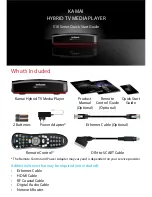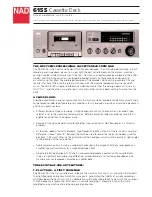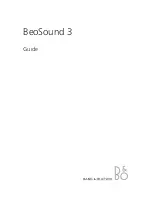
Appendices : Video Formats and Bandwidth
Page 237
•
12 bit leads to 4096 possible values
•
More bits for pixel sampling is only used for special cases like film color calibration and other computing
intensive processes.
•
Linear scale means that the input value is reflected with no change to the output
•
Logarithmic scale is a scale of measurement that outputs the logarithm of a physical quantity instead of
the quantity itself.
This is often used if the underlying quantity can take on a huge range of values; the logarithm reduces this to a
more manageable range. Some of our senses operate in a logarithmic fashion (doubling the input strength adds a
constant to the subjective signal strength), which makes logarithmic scales for these input quantities especially
appropriate. This type of scale is use in digital cinema to emulate the 35 mm film capability of high light transmis-
sion.
Frame Rate
•
23.98 HD
•
24 Film, HD
•
25 PAL, HD
•
29.97 NTSC, HD
•
30 HD
•
50 HD
•
59.94 HD
•
60 HD
We are using the term
frames
, but most common video formats use 2 fields per frame since they're interleaved.
This means that a frame is constructed from 2 fields (one for odd lines, one for even lines) displayed at twice the
frame rate of the video standard. To simplify the bandwidth computation, the frames value will be used.
Bandwidth Computation
Number of pixels per frame x color sampling value x bit depth x frame rate = number of bits per second
We will compute the required bandwidth for NTSC format with 8 bit 4.2.2 broadcast color sampling and 1080p
with 12 bit 4.4.4 for processing quality.
NTSC -> 159.5 Mbps -> 20 MB / s
1080 @ 29.98 fps -> 2133.6 Mbps -> 266.7 MB / s
These are the absolute minimum sustained performances required for network and storage.
These data rates can be reduced by using a data compression codec.
Compression Codecs
The previous computations show that video is a bit gluttonous. This bandwidth requirement has its price. That
why a data compression is frequently applied in order to reduce the data flow demands.
Loss-less
Loss-less codecs are mathematical solutions which regenerate the compressed data exactly. The compression
ratio is often lower than 3:1
Lossy
Lossy codecs are also mathematical solutions. But they are a compromise between efficiency and quality. The
compression ratio can vary from 3:1 (the quality is almost the same as the original) to more than 100:1 with visible
artefacts.
Intra Frame:
DV, MJPEG, IMX. Every frame is processed individually.
Содержание VCube
Страница 1: ...USER MANUAL User Manual...
Страница 9: ...Page 9 Document revision 22 Date 28th November 2012...
Страница 13: ...Introduction VCube Keys Options Page 13 VCube Versions...
Страница 196: ...Output View Output Page Diagnostic Tools Page 196 Audio Meters Shows audio Playback levels Output Page Audio Meters...
Страница 231: ...Appendices HDTV Recorded Media Page 231 HDTV Recorded Media SDTV Recorded Media...
Страница 264: ...Appendices Pro Tools VCube Operation Page 264 Pro Tools VCube Operation...
Страница 270: ...Appendices Pro Tools and VCube Page 270...
Страница 273: ...Appendices Pro Tools and VCube Page 273...
Страница 274: ...Appendices Pro Tools and VCube Page 274...
Страница 275: ...Appendices Sony 9 Pin RS422 Wiring Chart Page 275 Sony 9 Pin RS422 Wiring Chart...
Страница 276: ...Appendices Sony 9 Pin RS422 Wiring Chart Page 276...
Страница 277: ...Appendices Sony 9 Pin RS422 Wiring Chart Page 277...
Страница 278: ...Appendices Sony 9 Pin RS422 Wiring Chart Page 278...
















































